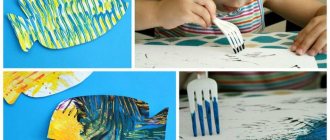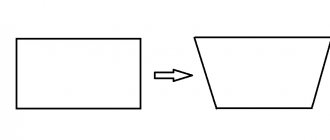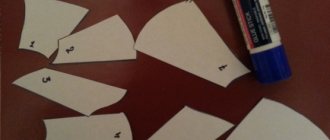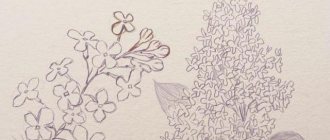Sunny light watercolor
You have repeatedly stopped near paintings of seascapes done in watercolors. The depicted ocean breeze filled you with inspiration and a passionate desire to try your hand at painting yourself. We offer a lesson containing specific steps to achieve the goal.
What is needed to create a beautiful landscape in watercolor:
- paper with a semi-smooth texture (use a small sheet to start);
- round brushes - No. 12 is the largest brush, No. 8 is medium-sized and No. 4 is the smallest brush;
- watercolor paints of recommended shades (they will be indicated during the proposed master class), they can be replaced with paints of your choice.
Let's start drawing
- The first step is to create a sketch. We draw the contours with a simple pencil and should be barely noticeable on paper.
- The second step is drawing the sky. We thoroughly wet the paper above the horizon line and give it time to soak it. Take a large brush and apply a few very light strokes using yellow paint. This is how we designate the clouds in the sky. The color of cobalt blue will be used to highlight the upper silhouettes of the clouds. We rinse the brush well and use it (let it be a little damp) to blur the outlines, in this way achieving fusion in the color scheme. Then we will continue to paint the sky with blue paint, at the same time marking the bottom of the clouds. Without letting the paper dry completely, draw shadows on the clouds. For this we will use blue and red colors.
- The third stage will be the most crucial moment - drawing the sea elements. We use brush No. 12. We apply phthalocyanine blue paint mixed with water on it in quite a large amount. We make the initial strokes using a technique, the essence of which is that the resulting mixture is applied to dry paper with sliding movements of the hand. We work with the whole brush and part of it alternately. Some areas on watercolor (grainy) paper will remain clean. This way we create the appearance of a sparkling expanse of water. On the water (the paper should remain damp) we create a little depth. We make several small strokes with blue and green paints.
- The fourth step will bring you much closer to completing the work. Mix blue and yellow colors and a small drop of red, and draw the silhouettes of the hills located on the edge of the horizon. Here you need to try hard to give the colors a muted hue and the contours blurry. In this way we emphasize the appearance of the remoteness of the hills. We will definitely wait until the area of the sea surface has completely dried and begin to draw water ripples and waves. We make the strokes larger and much richer than the individual details drawn.
- Step five is the final stage. We use brushes of medium size and the smallest in shape. We use them to draw the pencil-drawn outlines of the boat and people. We work with two shades of red paints, mixing them into one. The nuance in this drawing is that you should not thoroughly draw human figures. They will look more natural in a slightly messy image.
The work is completed. However, you can add your own additions, for example, enliven the picture with soaring seagulls.
The provided lesson will help you create a simple marine plot and, perhaps, give inspiration for painting with watercolors.
On the topic: methodological developments, presentations and notes
Abstract on artistic creativity.
Objectives: To teach children to embody their ideas about primroses (snowdrops, scillas) in artistic form. Improve applicative technique. Form compositional skills. Develop feelings
Continue to teach children to draw the sea, using various methods of depiction. Cultivate an interest in fine arts and poetry.
Topic: Drawing with soap foam. “Color the planet.” Purpose: To introduce children to a new technology of fine arts - drawing with soap foam.
This lesson teaches children to understand the imagery of poetry about the sea, teaches children to think through and implement the design of the drawing. Teaches children to draw the sea using various methods of depiction. R.
OOD notes for the senior group.
Drawing in the format # let's stay at home with benefit.
Source
Sea sunset in oil painting
Just yesterday you were enjoying the sea view, and today there is a snowy blizzard outside the window. It comes to your mind to depict an unforgettable sunset on the sea, and do it in oil to surprise your guests. It is worth noting that this is quite difficult for beginners. Experts strongly recommend attending special courses where you will be taught step-by-step lessons in oil painting. This is the best option for those who want to seriously engage in creating works of art on their own.
Amazing sea
- You should start your drawing with a thoughtful definition of the parts of the drawing: the horizon and the coastline in the plot you have planned. On land, sketch out the outlines of small boulders. Be clear about the beach line. If desired, draw a silhouette of the sun, mark the waves around the stone ledges in the sea.
- The next step will be to depict the initial outlines of the waves on the entire sea surface. To do this, make several strokes with a pencil over the entire water surface. However, don’t get carried away – quantity is no substitute for quality. Because in this case it will not be possible to depict fairly large waves.
- Next we move on to drawing and line painting the silhouettes of the waves near the stone figures. This is where you will need to use a specific technique. Pencil marks can be softened using your fingers (rubbing the line drawing with them), or using an eraser with sufficient rigidity. A similar procedure is carried out with part of the sea.
- Now let's move on to the design of the shore. Similar to the procedure with the sea surface, the sandy shore is shaded with pencil strokes and then rubbed. It is also quite possible to lighten dark places in sea areas (if there is such a thing). By intensively shading the stones we will achieve their expressiveness. Sketch the outlines of the clouds.
- This stage is intended to depict the heavenly expanse above the sea. Start by sketching out some small clouds. Faint strokes will emphasize the movement of air. Add a sun to the picture (optional).
A little perseverance and patience will help you cope with this lesson.
Black and white image
To work, you need to prepare a sheet of paper for drawing or drawing, a set of black graphite pencils of different hardness and an eraser for shading.
After preparation, you can proceed to the first stage:
- First, you should outline the details of the composition: the coastline and horizon, rock or stones, the disk of the setting sun.
- On the surface of the water, using a simple technique of drawing with strokes, you need to outline the silhouettes of the waves. Don't do too many high waves.
- Near the marked stones and boulders, paint with strokes and rub a little with a special eraser.
- In the same way, you can shade some areas of water.
- The surface of the shore is filled in the same way and shaded in the same way. The stones are darkened with a softer dark lead.
- On the horizon near the sun you can outline the silhouettes of clouds.
If you plan to depict high waves, there should be only a few of them. Small waves can unobtrusively cover the entire surface of the sea surface.
If you have managed to master the technique of depicting the sea with a pencil step by step, you can proceed to more complex options.
Bright gouache
Drawing with gouache paints is considered one of the easiest options for creating a seascape, accessible even to a child. Step-by-step instructions for children are available even to five-year-old painters.
If watercolor painting is complicated by subtle manipulations with water, the technique of using oil requires certain skills and knowledge, then gouache is not afraid of mistakes and mistakes, and does not require compliance with complex rules.
Before starting work you need to prepare:
- A sheet of thick, smooth paper;
- Set of gouache paints;
- brushes of different hardness and sizes;
- Palette;
- A glass for water and napkins.
Next you need to act according to the instructions:
- First, you should divide the sheet into two parts with a horizon line using a pencil. The smaller part will represent the sky, the larger part will represent the sea.
- To color the heavenly heights, blue and white colors are mixed with wide horizontal stripes. The upper edge of the sky should be darker, gradually shading downwards.
- At the second stage, clouds are drawn. Their contours are indicated by thick dots, which, while the paint is still wet, are rubbed with a napkin to depict a fluffy effect.
- To paint the sea part of the picture, blue, green and white paints are mixed. The bottom should appear darker, gradually darkening towards the horizon line.
- Children like to depict splashes of sea foam with drops of paint. You need to take a hard brush or toothbrush, dip it in white paint and run your finger along the bristles towards you. Foamy sea spray will appear on the surface of the painting.
The picture can be complemented by dark blurry silhouettes of a distant island on the side of the picture, and small checkmarks of distant seagulls.
Seascapes have the ability to create a mood, evoking romantic thoughts and arousing the desire to travel. The beauty of the sea cannot leave anyone indifferent.







